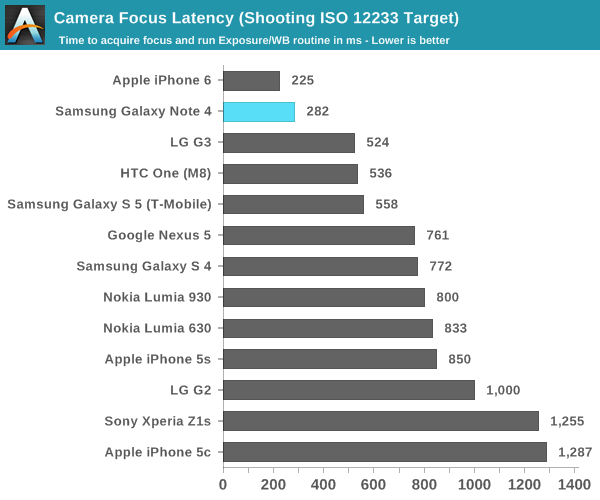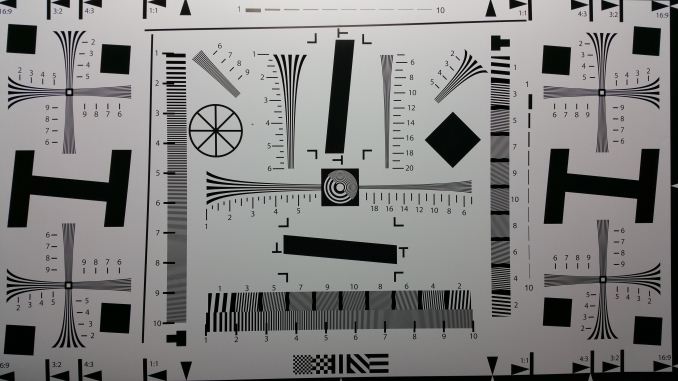The Samsung Galaxy Note 4 Review
by Joshua Ho on October 15, 2014 9:00 AM EST- Posted in
- Smartphones
- Samsung
- Android
- Mobile
- Galaxy Note 4
Camera
While the 16MP camera of the Galaxy Note 4 is mostly what we would expect, Samsung has really changed things up with the addition of OIS. Outside of this addition and the Sony IMX240 sensor, there’s really not a lot of change when it comes to the Galaxy Note 4. This means that we see the same 31mm equivalent focal length and F/2.27 aperture. At this point, it seems that OIS has finally reached mainstream adoption as both Samsung and Apple are shipping OIS solutions on their phones. The front facing camera is noticeably different though, with a Samsung S5K6D1YX sensor that I haven't seen elsewhere.
However, before we get into the proper image quality analysis I wanted to first cover shot to shot latency and focus/AE latency, as both are critical to a good image capture experience. Even if it’s possible to get amazing photos from a camera, it doesn’t really matter if the moment is missed. In order to test this, we look at the ideal case, which is when the phone is pointed at the ISO chart with bright lighting to maximize contrast.


As one can see in the graphs above, capture latency and focus latency are quite competitive with on the Note 4. However, there is one crucial detail that the focus latency graph misses, which is that Samsung doesn’t have continuous auto-focus in preview with the Note 4. As a result, there’s realistically an additional latency period before the auto-focus begins to run. The result is that the total time from out of focus to in focus is realistically closer to 800ms, but if one immediately taps the display to begin an AF run it’s possible to achieve the lower bound value, which is just south of 300ms.
Still Image Performance
While I'm still working on moving towards a better test for cameras, for now we have our standard photo comparisons that should give a good idea of what to expect from a smartphone camera in comparison to other cameras. Our first test is the standard ISO chart, which allows for a good test of maximum resolution.

For this first test, it seems that Samsung hasn't really changed much when it comes to maximum resolution, and in general the Note 4 produces similar output to the Galaxy S5. To verify this and a test of dynamic range, we'll look at a landscape shot next.
In this test, we see that the Galaxy Note 4 generally does well with detail and dynamic range as the landscape is generally well-detailed, although there's quite a bit of detail that seems to be smudged away on the grass as it seems to be a flat green texture for the most part. There's also noticeable color artifacting on the bleachers in the distance. We'll look at the same scene in low light to get a better idea for what the Note 4 really brings to the table.
Here, in low light we see significant improvements in image quality when comparing the Galaxy S5 to the Galaxy Note 4. The iPhone 6 Plus and Note 4 are quite close in overal quality, but looking at the brick building on the right of the image shows that the iPhone 6 Plus is maintaining a higher level of detail in this scene.
In the case of HDR, Samsung continues to do a great job with their implementation. For the most part this feature is successfully implemented with no real halos or other artifacts even when there are moving objects in the shot. This is likely to be implemented through on-sensor HDR rather than image combination.





































195 Comments
View All Comments
MattL - Thursday, October 16, 2014 - link
Not strange at all, often certain places will get early review devices, they got an early iPhone 6 and 6+ too.Arcetnathon7 - Thursday, October 16, 2014 - link
Yes, but every early review of iPhone 6 and 6+ are "strangely" without any benchmarks.We always have to wait for Anandtech :)
MattL - Friday, October 17, 2014 - link
Well Display Mate had Note 4 and iPhone 6 Plus screen reviews up for a while now... I honestly would trust them more on the screen side of things anyways (they are far more comprehensive in their analysis and are obviously specialized experts in screens)... just curious as to the differences seen between theirs and the analysis here since they found the Note 4 definitely more accurate vs here.I do agree that you see very few iPhone 6 reviews with benchmarks though.
I would be very interested in other sites doing in-depth screen analysis runs, should give a better picture... but unfortunately not many sites do and the couple others I have seen are *horrible*, they didn't even realize that the Note 4's screen modes actually supported different color gamuts so they critiqued the color accuracy on the Adaptive mode specifically designed to have a high saturation of the color gamut to fend off ambient light washing out that saturation or the Photo mode which supports the Adobe RGB color gamut (17% larger than sRGB) do a high degree of accuracy, but when viewing non Adobe RGB content it will analyze off obviously. While the Basic mode is designed to be extremely color accurate to the sRGB standard (again Display Mate found it to be the most accurate of any smartphone or tablet screen, even the iPhone 6 screens)... so those sites results are pointless.
tralalalalalala40 - Saturday, October 18, 2014 - link
Does the user have to manually change the color scheme on the note4 for every app?tralalalalalala40 - Saturday, October 18, 2014 - link
The golden phone review, hand picked by robots maybe? At least they aren't programming their phones to cheat benchmarks anymore (most likely)trynberg - Wednesday, October 15, 2014 - link
So, the iPhone 6+ is declared the best phablet with no supporting statements or qualifications. The Note 4 gets "remains one of the best phablets on the market, but whether it's the best for a given user is a matter of priorities and personal preference rather than any absolutes".I mean, how blind do you have to be to not see the bias there?
KPOM - Wednesday, October 15, 2014 - link
This is actually a much more positive review of the Note 4 than ArsTechnica. AT basically said it comes down to your OS preference.MattL - Thursday, October 16, 2014 - link
Ars had the most negative Note 4 review I've seen anywhere on the web... really surprised about that, very disappointed.tralalalalalala40 - Saturday, October 18, 2014 - link
Go to samsung's website, they have a great review of the note 4 that should cheer you up.TrackSmart - Wednesday, October 15, 2014 - link
Thanks for the review! As always, this is much more complete information than you find at competing sites.That said, the Battery Charging Speed Test is not as useful as it could be. Supposedly this phone charges to 50% in the first 30 minutes. That means most of your testing time represents "topping off" the battery. Consider adding 50% or 75% charge speeds instead of (or in addition to) 100%. It would tell us which phones allow a user to quickly get back to business.